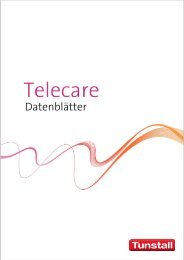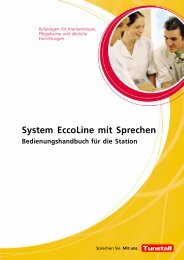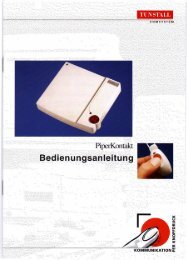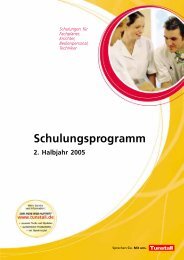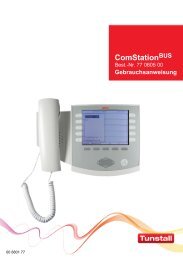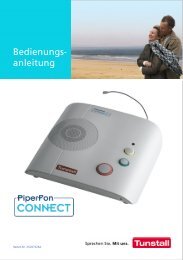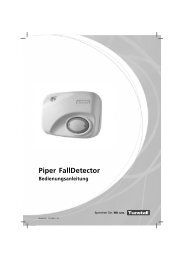You also want an ePaper? Increase the reach of your titles
YUMPU automatically turns print PDFs into web optimized ePapers that Google loves.
Power supply unit UPS 60, Order No. 77 3400 10<br />
The power supply unit UPS 60 is a power supply unit and includes the electronics that builds up an<br />
uninterrupted power supply (UPS) in combination with battery set for UPS 60 (order no. 77 3450 00).<br />
Input voltage of 115 - 230 V AC is transformed into 24 V DC output voltage. The UPS feature ensures<br />
the supply of the connected DC users also in case of a mains power failure.<br />
If the mains input voltage fails or when it drops to less than 90 VAC, the two connected lead batteries<br />
will continue to supply the users without any interruption.<br />
To protect the batteries from going flat, circuit breakers will open when during the UPS mode the<br />
output voltage drops below to 19.5 V. When the mains supply voltage is active again, the system<br />
reverts to its normal operating mode.<br />
Roughly every 15 minutes, an integrated test circuitry performs a voltage check at the battery<br />
terminals, the connections and at the circuit breakers. Upon the return of the mains supply current, the<br />
battery is isolated from the outputs, and the internal charging module recharges the battery.<br />
Safety instructions<br />
1. Mounting<br />
• Non-compliance with the safety instruction or improper handling of the unit (e.g. skin<br />
contact with live components when the unit is open) can be extremely dangerous.<br />
• The power supply unit UPS 60 should only be installed and commissioned by<br />
qualified specialists.<br />
• Before effecting any work at or with the unit, it must be isolated from any voltage<br />
(mains or battery).<br />
• Connection to the mains supply must be executed acc. to the valid national<br />
regulations (for Germany: VDE 0100 and VDE 0160).<br />
• Fuse or circuit breaker must be provided for safe isolation from the input (mains)<br />
current.<br />
• Overheating of the unit may occur when the values as shown in the technical data<br />
are exceeded. This may lead to permanent damage to the unit, and system safety is<br />
jeopardised.<br />
• Always watch for the safe isolation of AC and DC circuits!<br />
• Observe the general safety instructions for the handling of batteries! Sufficient<br />
ventilation must be provided to preclude the development of an explosive hydrogenair<br />
mixture!<br />
• If the power supply unit UPS 60 will not be used for a longer time, first the batteries<br />
have to be fully charged. After that the power supply unit UPS 60 has to be<br />
disconnected from the mains supply. Furthermore the battery connection cable must<br />
be disconnected from the battery set for UPS 60 (see chapter 2.1). Alternatively the<br />
battery fuse in the battery set for UPS 60 can be removed.<br />
The power supply unit UPS 60 is designed for wall mounting. Bore holes are prepared at the housing<br />
for fixing the unit at the wall using the enclosed mounting material. A dimensional drawing is shown on<br />
the next page.<br />
Before mounting, check the condition of the wall itself.<br />
The power supply unit UPS 60 weighs approx. 4 kg.<br />
The unit must be mounted such that the venting ports are at the top and bottom.<br />
The selected location must ensure sufficient air circulation above and below the unit. Therefore, check<br />
for minimum distance of 50 mm to walls, ceiling and other equipment. The venting ports must not be<br />
covered up. Insufficient air circulation may lead to damage to the power supply unit.<br />
© <strong>Tunstall</strong> <strong>GmbH</strong>, Orkotten 66, 48291 Telgte, Germany, www.tunstall.de, 00 8802 81, Rev. 2.1 (05/2008) English - 1<br />
<strong>Technical</strong> <strong>Manual</strong> Page 144



